Avoiding Insanity: AAC & the Pace of Change

Although the field of AAC emerged only in the last few decades, the notion of communicating in alternative ways is centuries old. In classical times, the use of manual communication by deaf individuals was referred to by Plato and documented in Europe during the Middle Ages. In North America, American Indian Hand Talk evolved over generations to allow cross-cultural communication between speakers of diverse languages.
As a clinical/educational field, AAC has been described as evolving through a “bottom-up” mechanism. Individuals with congenital conditions that prevented the development of intelligible speech invented their own communication systems long before teachers, therapists, and clinicians formalized instruction in alternative modes of expression. AAC users growing up in the forties and fifties tell of communicating through grunts, vocalizations, “air writing,” and eye movements, which, though effective in some contexts, were maddening in their limitations.
Individuals who were fortunate enough to have access to habilitative and therapeutic services did not fare much better than those left to their own creativity. With few exceptions, even the most well-intentioned professionals had little to offer, working on cognitive prerequisites to communication or oral motor and articulation skills that failed to improve noticeably despite years of therapy. Respite and solutions sometimes came from unexpected sources. Michael Williams, editor of the periodical Alternatively Speaking (no longer in publication), reflected on his own situation.
“I used air writing to communicate with people outside my family until I was well out of college. All this changed very dramatically one day when I was working at my job as a volunteer news writer for a radio station in Los Angeles. One of my coworkers became extremely irritated with my mode of communication. He found it extremely slow and tedious. He walked in the next day and threw a checkbook cover at me. I opened it and found the letters of the alphabet pasted inside. My friend had given me what all these professionals I had seen over the years had not given me: an alternative means of communication.” (1995, p. 3)
There were a few pioneers who did, in fact, try implementing nonspeech modes of communication with their clients with aphasia and cerebral palsy. Although these early efforts were successful, information on these strategies and tools was slow to trickle down to the average clinician. In essence, the service delivery profile for individuals with severe communication disabilities improved little until the mid-late 1970’s.
In the US, three factors catalyzed changes in our approach to intervention with individuals with severe communication impairments. The first was the passage of several pieces of legislation. The Rehabilitation Act of 1973 prohibited discrimination against people with disabilities, helping to create an environment in which disabled individuals participated more actively in mainstream society. In 1975, P.L. 94-142 mandated change in the educational system. For the first time, all children with significant disabilities were legally entitled to a free, appropriate education, thus attracting the attention of school-based speech-language pathologists. The second factor was an expansion of our knowledge base in the areas of linguistics and language development. In the early seventies, researchers such as Bates and Dore were investigating the function rather than the form of language. This broadened our scope from one that was speech-focused to one that was communication-focused, creating an environment more conducive to exploration of less conventional means of expression. Finally, microprocessor and switch technology began to be applied to individuals with communication disorders.
By the late seventies, alternative means of communication were beginning to be seen as a viable approach for some individuals who failed to develop or regain intelligible speech. In 1981, ASHA developed a position paper on AAC services, and delineated competencies for professionals interested in providing these services. Although recognized as a legitimate approach with this population, AAC intervention was still far from commonplace. The first AAC courses and workshops began to be taught, but most practicing clinicians had little awareness or direct knowledge of how to implement these new strategies and techniques.
During the past 30 years, the AAC field experienced explosive growth with the development of the International Society for Augmentative and Alternative Communication (ISAAC), the AAC Journal (1985), and a proliferation of textbooks, continuing education workshops, conference presentations, and pre-professional coursework.
And yet, we still have a population of individuals whose need for AAC goes unmet. Earlier this year, 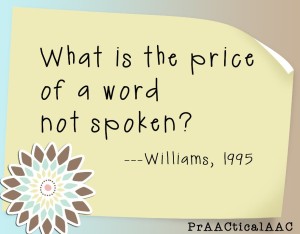 many of us read a white paper developed through the joint effort of an AT/AAC company and two university professors, which shared findings of a questionnaire circulated online to AAC stakeholders. A summary of their results included these findings:
many of us read a white paper developed through the joint effort of an AT/AAC company and two university professors, which shared findings of a questionnaire circulated online to AAC stakeholders. A summary of their results included these findings:
-
Less than 10% of adult AAC users report receiving professional support to effectively implement AAC.
-
Close to 20% of the professionals consider the practitioner charged with supporting the person with AAC needs as being not knowledgeable or only slightly knowledgeable about AAC.
At a meeting last night, there were many families of adolescents with significant communication difficulties and several of their teachers. In the entire room, it seemed that only one child had an appropriate AAC system. Just one.
Clearly, something isn’t working in the AAC field. With all the our research, our writing, our teaching, our therapy, our conferences, and our advocacy, something isn’t working. What we are doing to give communication access to this population is just not working. Or not working well enough.
Einstein is credited with defining insanity as doing the same thing over and over and expecting a different result. Well, we’re not crazy. Really, we’re not. We are all good thinkers. We’re creative problem-solvers. We all work way too hard. And we all have big dreams and goals and expectations for people who have yet to access real language and communication development. So why are we doing the same thing over and over and expecting a different result?
There has to be a better way. Anyone want to open a dialogue to what we in the speech-language profession can do differently so that the pace of change gets accelerated? We need better solutions. Not complaints, not rants, both of which we (Robin and I) do far too often. The AAC field needs new, fresh ideas for things to try. Really, there has to be a better way.
What can we do differently to accelerate the pace of change in AAC?
Ideas, please. Big ones, small ones. Logical thoughts and off-the-wall sparks. Ideas for researchers, practitioners, administrators, clinical educators, bloggers, presenters. Share your thoughts. We’re listening.
Filed under: PrAACtical Thinking
Tagged With: advocacy, change, historical perspective, ideas
This post was written by Carole Zangari

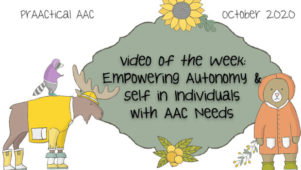
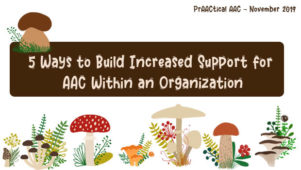
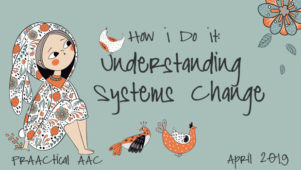
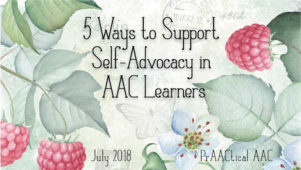
24 Comments
Carole, I could not agree more with your post, and it brings tears to my eyes. I have horror stories, as do we all, but I agree that ranting to the converted will not help fix the situation.
One area where we may be able to make some sort of difference is to change the ASHA standards for academic accreditation and SLP certification to require practical knowledge of AAC. The standards in place result in mere “exposure” to AAC in pre-service training. The resistance to incorporating AAC into university programs is significant. We SLPs are expected to be competent in so many diverse areas, and there is just not enough time in a two year masters program to adequately cover them all. The AAC requirement for preservice now allows accredited universities to graduate SLPs who have never had actual experience with a non-speaking client, and very little if any ideas for what to do when they meet their first non-speaking client or student. We are all required to take courses in voice and fluency (very important topics, I’m not denying that!) And yet when you look at ASHA’s surveys on school caseloads, you see that the need for AAC expertise is actually greater than that for voice and fluency. Caseload characteristics trends reports for 1995-2012 show that since 1995, about 50% of school SLPs have one or more students on their caseloads who are described as needing AAC. SLPs with such students on their caseloads serve about 4 – 5 students who need AAC. These numbers have been relatively consistent across studies. While this is not as many as the students who require articulation or phonological therapy (ranging from 21 – 24 students per SLP), it is more than those who require fluency therapy (2 – 3 students) or voice (including resonance) therapy (0 – 2 students).
So one area we as SLPs and ASHA members can work on is getting the ASHA accreditation and competency requirements changed. The AAC SIG 12 leadership is aware of the issue and is looking at ways to work within the ASHA bureaucracy to make that happen, and those of us who are SIG 12 members can help their efforts and lobby within ASHA for AAC as a “line item” for SLP pre-service training. That’s by no means a complete solution, but it’s a step in the right direction.
Full disclosure: In addition to working in the schools with students with AAC needs, I also consult with AssistiveWare on Proloquo2Go.
Jennifer, thanks for your thoughtful comment. You make a very good point that, in the US, CAA accreditation standards are a great influence on what is required in graduate SLP programs. One point of clarification is that CAA doesn’t actually require classes in specific content areas. Rather, they require the programs to ensure that the students develop competencies in certain areas, but they leave it up to the programs to determine how to do that. Anyone who wants to look at the standards that will go into effect in 2013 can check their site: http://bit.ly/O8a0Ub. I would love to see more of a presence of AAC in the accreditation standards and many of us have made that case when the call for comments has come out. There has been some change over the years, but not nearly enough, as your numbers indicate. Very few people actually make comments on the draft accreditation documents, and even fewer who speak to the need for AAC. Some do, but very few. It’s a shame because they really take those comments into consideration. It would be great to see more SLPs who are vocal AAC advocates get on some of these boards, committees, and task forces. You’ve hit on a really important area, Jennifer. Thanks for getting the conversation started!
If we can’t move the universities via ASHA standards (because they are so broad and the competencies can be “met” in so many ways), let’s consider other ways to influence curricula (and by the way, influence AAC practice within the university clinic and related practica!). If you are an AAC advocate – SLP or family member – and you graduated from college – use your “alumnus” voice to talk about how the CSD program MUST include consumers who use AAC. Talk about the good job – or not so good job – your school did on preparing you in this area! If you graduated from University Y and are a parent/family member/other stakeholder who didn’t major in communication sciences/disorders, and you have first hand knowledge of the good/not good job that its CSD graduates do in AAC – LET THEM KNOW! (Even consider donating to support their AAC efforts). If you are an AAC user or family member – OFFER to come and talk to CSD students…Like most systems change efforts, it will probably take both top down and bottom up efforts!
Could not be said better by the post and previous comments. I couldn’t agree more that education of SLP’s is important but we need to add special educators, general educators, allied health professionals with at least the basic AAC information because until we get a ‘tipping point’ (Malcom Gladwell) of knowledge out there we will be fighting the same battles.
Excellent point, Robin! SLPs alone are “necessary but not sufficient” to changing the current AAC landscape. Implementing AAC right (or even semi-right 🙂 requires an entire team – an SLP cannot come close to doing it all!
Thanks…and Yes, I agree. Your perspective made the concept even broader and more collaborative by using the word ‘TEAM” and in AAC everyone has a part in making it work!
So much of this is how we get the message out. I came across an interesting quote from Bill Bernbach, a legendary ad exec of the Mad Men era. “The truth isn’t the truth until people believe you, and they can’t believe you if they don’t know what you’re saying, and they can’t know what you’re saying if they don’t listen to you, and they won’t listen to you if you’re not interesting, and you won’t be interesting unless you say things imaginatively, originally, freshly.” We have to keep looking for fresh ways to really reach people with the AAC message.
“Could not be said better by the post and previous comments. I couldn’t agree more that education of SLP’s is important but we need to add special educators, general educators, allied health professionals with at least the basic AAC information because until we get a ‘tipping point’ (Malcom Gladwell) of knowledge out there we will be fighting the same battles.”
Let’s not forget about the parents 🙂 I was lucky enough to learn of AAC early enough to make a big difference for Maya as her language is developing, but I see way too many of her peers (at special needs preschool) who have very limited expressive language . . . but the parents just aren’t aware that AAC is even a possibility. Or they use PECs at school, but the parents aren’t educated and empowered to mimic the system at home.
Dana, you’re so right on all these points. We didn’t mean to suggest that the ‘solution’ should be restricted to SLPs. I was just thinking that we SLPs need to get our own house in order (and fast!). It is just so discouraging to me that so many SLPs are practicing without having AAC options on their radar. More SLPs see kids who need AAC than kids who need voice or fluency therapies. And yet many still feel it is ‘okay’ not to get up to speed on AAC.
I agree that there remain serious issues related to AAC service delivery. I have seen the negative examples and the consequences. I have also seen them since I started in the field, way before iOS even existed.
On the other hand, I know that there are truly amazing people out there providing high quality service on a regular basis. We can focus on the lack of preparation or we can find these outstanding individuals and shine a bright light on them. I know they are out there. Let’s work together to find them, reward them, and let others learn from them. Let’s inspire the field again. Let’s focus on our strengths and not our weaknesses. Wouldn’t we want to do the same for the people we serve?
John, focusing on the positive is always a good thing! Thanks for your suggestion. We’ve had some very good discussions since this post was first published and are going to do something along the lines of what you suggested by highlighting SLPs doing great AAC work. If you have anyone in mind that would be a good fit for this series, please have them get in touch. The more, the merrier!
Great comments…….I am a parent of a teen AAC user(he has used AAC since age 3).
Casey, thanks for your comment. We are always happy to hear from families who have been down the ‘AAC road’ for a decade or more and are still at it. 🙂
As the parent of a child who definitely doesn’t have the right AAC solution yet….
More training for SLPs would be good – our school district doesn’t seem to have anyone at the preschool level who has experience in implementing an electronic AAC device of any sort, and limited experience with PECS beyond one or two symbol communications. They are dependent on an expert from the county ISD, who they talk to every 6 weeks (not frequently enough for turn around when they see a problem). They don’t have devices on hand, so it’s weeks and weeks to get a device to a child to even get started.
Similarly, our private SLP is phenomenal….but she has no AAC experience. In fact, no one at our hospital’s therapy office does. Another hospital has an assessment group, and the wait time there is months for an evaluation (and challenging to get the insurance to cover, since they’re at a different hospital and thus out of network). After they decide what we would need, we still have no one who can guide in implementation.
We’re smart people – an engineer and an IT manager. Our kid is smarter than he lets on. We *get* how to teach sign language, and are making progress there, though his motor skills will eventually make that less functional than one would hope. But we are at a loss of how to teach him to use core vocabulary (and the device the school has given has *only* core vocab – no nouns, no adjectives…..which are the things that are most motivating to him in sign language, because he can use them to get exactly what he wants). We’ve read the studies. We just have no guidance in the field.
Janet, your situation is too common and that’s really why we took this on. There are great SLPs out there but too few are well-versed enough in AAC to meet all the needs that are out there. Dr. McCarthy’s suggestion to focus on the positive work of experienced AAC clinicians is giving us food for thought. We’d love to hear even more ideas of how to accelerate the pace of change so that a greater number of SLPs feel comfortable guiding families and other team members about implementing AAC. In terms of your specific situation, have you looked at the great site by Penn State on early intervention & AAC (http://bit.ly/KnZlkx)? It doesn’t address the need to design or expand a system beyond core words, but has some really helpful information about the teaching process. Just wanted to be sure you knew it was out there. 🙂
Thanks for gathering ideas on this topic. I believe the positive approach is one that should be emphasized. I am trying now to work within my own department to highlight outstanding students over identifying problem ones. There is a subtle shift in this approach and one I hope that will grow. Obviously the behavioral principle involved is nothing new. There is a need though, when I perceive myself to be “stuck” in a slow moving system, to follow examples rather than to detail the problems.
In a related point to moving systems, SLPs in particular are quite good at assessment. We can analyze and detail problems from multiple perspectives. I believe the field is ready for a more dynamic assessment at this point. Let’s intervene and react to that. In addition to positive SLP exemplars, I believe individuals in personnel preparation could do more to partner with individuals who use AAC and their families.
The exact methods of implementation are certainly another topic for discussion…
In the interest of full disclosure, my comment about clinical examples was partly inspired by a resource I am developing with Dr. Aimee Dietz. (Feel free to moderate out the link. The resource is not available yet so I’m just providing an example.)
AAC Casebook
There have been other efforts in this positive example area. I remember CAPCSD was behind a Master Clinician network
Master Clinician Network>
I confess that I have not participated to date, but would love to hear some feedback on any AAC related experiences.
ASHA used to have a Grand Rounds in AAC presentation that worked along similar lines to positive examples as well.
If those from the academic community are to be involved in positive example efforts, the work would need to be done in the context of those activities of research, teaching, and service within each person’s host institution. To involve working clinicians means accessing people who are already extremely busy and asking them to participate in something that would take them away from the important daily work they are involved in. Likewise people who use AAC and their families are also extremely busy and would need assisting translating their perspectives in a way accessible to working and pre-service SLPs.
My opinion is that collaborative efforts are needed for large scale efforts to be achieved, but that local shifts to the positive are also wonderful places to start.
Happy New Year!
Thanks for sharing those thoughts, John, and congratulations on the upcoming book! We’ll definitely look out for that. I’ve used the Master Clinician Network a bit and it has good potential. One limiting factor is that with all the HIPAA and FERPA guidelines, fewer SLPs are comfortable sharing videos. I do remember those AAC Grand Rounds. It would be great to see that reinstated for those of us already invested in AAC. I will suggest that to the AAC SIG for 2013.
Thanks – I had not found that site yet, but we’ll be looking (our 19 month old has a trach and thus a speech delay too, and while her prospects for eventual normal verbal communication are much higher than our preschooler’s at this point, we’re all assuming she needs access to all the options available until we get there).
One thing that I really think might help – do SLPs require ongoing training, the way nurses and many teachers do? Are there workshops they can take as a part of that, local to them (because travel budgets are nil) or in an online collaborative environment, that teach these things? Workshops talk about vocabulary selection, device options (can you get OTs to sit in on this? They see the things that would inform an IEP team about what would be a good choice for a child….), language modeling, etc? Even just a basic overview and general principles with resources for them to follow up would be a great starting point, because exposure seems to be a big problem here.
Our private SLP said to me that another parent with a child with a new AAC device told her they had to model the use of it, and she hadn’t really even considered why you’d do that, for example, because she has virtually no exposure to any sort of device. Our school district gives every child the same device as a starting point (and in the first month, we all knew it was the wrong device for our little guy, and his OT probably could have told them as much, but there was no way to get the situation resolved until the expert came back, and their policy is not to change devices for a year without “good” reason).
Janet, SLPs are among the those who are very good about participating in continuing education. Last year, the ASHA special interest group on AAC hosted a week-long online conference on how to support communication partners. It was a really great event with high quality presentations and the convenience of doing it from home. I hope there are more of those in the wings.
I agree that AAC education is important, and it needs to be targeted to all team members. It seems to me that SLP graduate programs have made more of an effort to include exposure to AAC as part of the curriculum, but exposure to AAC does not translate to clinical competence and confidence. The barriers that I run into have to do with the belief that the children are “cognitively low” or “too behavioral” for AAC. These opinions are given by some SLPs (sadly) and by experts who are not SLPs. In some of these cases, other disciplines are making communication books and decisions about devices because the SLP does not have enough AAC confidence.
I think that while all of the professionals need to be educated, the key to accelerating the pace of AAC and getting it into the hands of children who need it, is to educate the parents. If parents are educated about their rights, empowered to push for AAC if their child is not able to communicate verbally, and validated as being an assertive advocate as opposed to “difficult,” SLPs will be motivated to research AAC options to be prepared for that parent. We can offer workshops, webinars, and articles, but people have to be motivated to learn and open to change. Once they are able to see a child use AAC successfully, it opens the door for other children who are nonverbal.
Full disclosure: In addition to working with children (age 3-21) to implement and support AAC, I am one of the creators of the Speak for Yourself app.
Heidi, I agree that grad programs have been increasing their efforts toward preservice education in AAC. Many also have clinical experiences in AAC so that their students get the hands-on piece, but we all know how much clinical work it takes to gain competence in any treatment area. One thing that I have been doing is to encourage ASHA to push hard for increased grant funding for SLP personnel preparation programs. (Every year, ASHA seeks input from members on what to have the organization focus on in their lobbying efforts.) There have been outstanding grant-funded AAC programs for master’s students over the years at Penn State, Nebraska, Purdue, San Francisco State, and other places. When well-funded, those special programs can give those students in-depth coursework, solid clinical experiences, and lots of other things that really get them on the road to developing competence. Another advantage is that some of the grant activities then get institutionalized so that they live on after the grant expires. For awhile, these AAC programs seemed to get a good bit of funding but more is always needed. Thanks for taking the time to share your thoughts.
I am the parent of an 18 yo with autism and an intellectual disability. He has used a variety of AAC systems from low tech to high tech. I would like to see the approach shift from “teaching” in a clinic or classroom to supporting the users and caregivers in the settings where real life communication occurs. There are lots of webinars and online resources that teach how to use AAC devices. We need support in the field. We need a coaching approach.
Betsy, some of my fondest therapy memories are with clients in homes, stores, restaurants, and (a very memorable one) in a bank. In the US, many SLPs really love getting into the community with their clients, but the increased constraints imposed by payors makes it difficult or even impossible. As much as technology has given us over the past few decades, I know, too, that we have lost something. On our holiday wish list: The flexibility of seeing the clients who need us for as much time as they need us and in the locations where they can most benefit. Thanks for taking the time to stop by and make this comment, Betsy. You point is a good one!
As a brand new SLP I was exposed to the best information from the technology lead at the school district I worked at. I worked hard with implementing AAC with all of my students who did not have sufficient verbal speech to communicate. Believing that each child has a fundamental right to having access to sufficient means to express themselves required that I practice a lot with my students. This resulted in me being a lot more comfortable with supporting AAC users as an SLP. I have recently faced a lot of resistance with my recommendations from ABA therapists. My current solution has been to educate parents and other professionals who work with children and who are willing to listen. I have planned an inservice for my early intervention teammates to help them be better equipped to educate the parents they work with. The education that I do with parents is not just surface explanations. I educate them about language development, AAC terms, demonstrate during therapy and facilitate the parents practicing with their child during therapy sessions. My strategy has been to educate parents and to get the word out to other disciplines working with children and parents. While ideally an SLP is working with all children who have language impairment this is not the case. Educating other professionals about AAC and encouraging them to encourage their children’s parents to seek SLP services is important in getting appropriate AAC into the hands of children who need it.